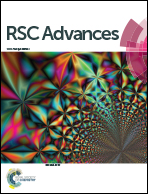Effect of phosphorus content on mechanical properties of polymeric nickel composite materials with a diamond-structure microlattice
Abstract
Periodical and ordered polymer–nickel-coated composite materials with a diamond-structure microlattice and various contents of phosphorus (4.10 wt%, 8.01 wt%, 12.25 wt%, 16.08 wt%, 20.21 wt%) were fabricated via electroless nickel–phosphorus (Ni–P) coating onto diamond-structured polymeric templates using a 3D printing stereo lithography apparatus. With the increase in P content, the crystal morphology transfers from crystal to non-crystal. By controlling identical 1.0 μm-thickness of 5 different content coatings onto templates, the properties of 5 different microlattice composites were tested by uniaxial compression. To confirm the thickness and P content, several mathematical models were developed to direct the subsequent experiments and all theoretical predictions are in agreement with factual characterization. The composite with 8.01 wt% phosphorus content and density of 240.4 kg m−3 performs best, with the maximum compressive strength reaches 1.08 MPa, which is 2.1 times higher than that of polymer templates.



 Please wait while we load your content...
Please wait while we load your content...